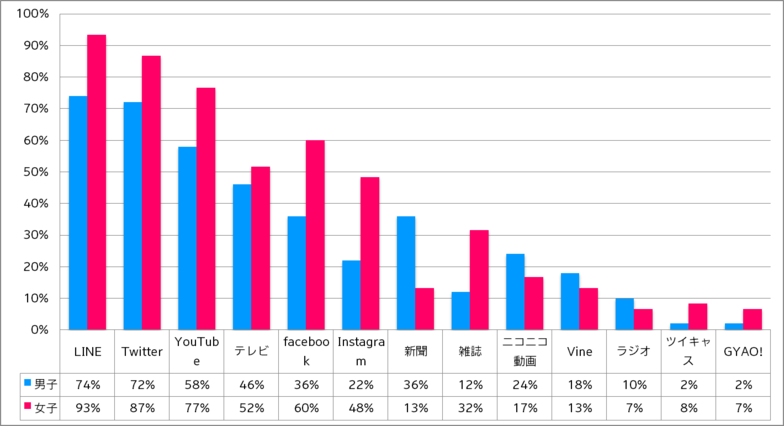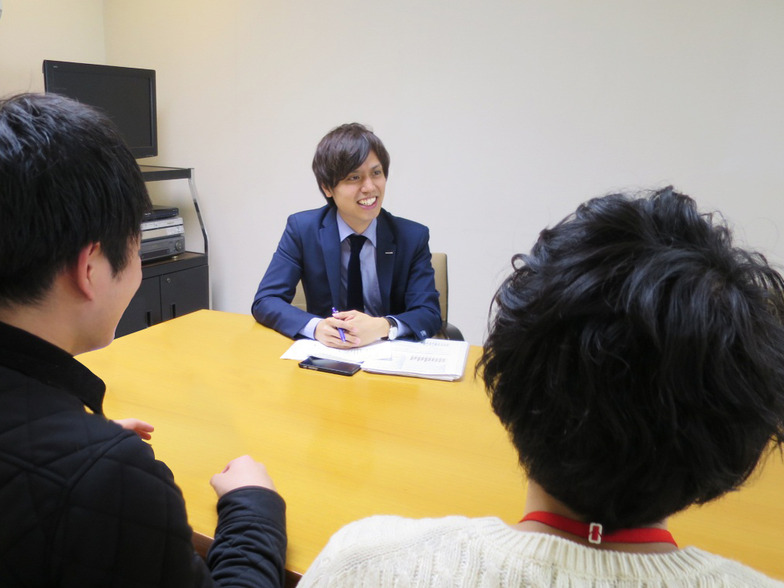What media are today's youth exposed to, and how do they behave? This time, we explored the reality of these young people while considering the mindset of today's youth.
The following data is a portion of survey results (conducted in January 2015) using "Circle Up," an app operated by Wakamon for university student clubs, regarding the media they regularly engage with.
The figures for internet media like LINE, Twitter, and YouTube are high, indicating particularly high exposure rates to media frequently accessed via smartphones.
Now, let's examine this data by gender.

(n=110, Circle Up users in their first to fourth year of university)
Instagram showed the largest gender gap in exposure rates. Instagram is a photo-sharing SNS commonly used on smartphones. Beyond just Instagram, services that frequently utilize smartphone cameras tend to be perceived as being used more by women than men.
Therefore, in a workshop with members of the free paper circle "Iki" (a student group composed of Nagoya University students), we gathered real insights from seven university students (three female, four male) on this topic.
Three female students had an average of over 10 camera-related apps installed on their smartphones, distinguishing between apps "for taking photos" and "for editing." The most frequently used app, including among their female friends, was "Camera360," which they said was excellent for "enhancing" (making photos look cuter through editing and retouching).
In contrast, the four male students only used the camera app that came pre-installed on their phones and never used any photo editing apps. Female students were overwhelmingly more adept at using camera apps than we had imagined.
Why has such a gender gap emerged?
I believe this gender gap reflects the mindset of today's youth.
During a workshop with the students, we had the following exchange:
Whether they can take "flattering photos"
Furuhashi: When you go to Halloween parties, limo parties, or other events, do you always want to take pictures?
A: My friends who always go to those events definitely take pictures and post them on Twitter and stuff.
Person B: When I went sightseeing in Tokyo with friends before, we went to a Lolita fashion shop in Harajuku because we could cosplay and take pictures. If I couldn't take pictures, I probably wouldn't have tried it.
A: It's the same with girls' nights out for pancakes. Honestly, it's less about wanting pancakes and more about wanting that "Yay!" feeling of us eating pancakes together, taking fun group photos, and posting them on social media (laugh).
C: Totally. If a pancake place didn't let you take photos, I'd never go there (laughs).
B: Like dressing up as Santa for a Christmas party—part of that is definitely to take flattering photos of ourselves. So I think it's absolutely unthinkable not to take photos at events like that.
Furuhashi: Is it really important whether the photos you take look good or not?
B: It's the most important thing! If I don't look good, I actually don't want to take them (laugh). I wouldn't want to post them on SNS either.
Furuhashi: I see. So for female students, whether they can get flattering photos suitable for sharing on SNS is a crucial factor in deciding what to do. How about you guys?
D: I don't really feel like taking photos. At a Halloween party, for example, it's more about how silly we can look and enjoying the moment together than the photos.
E-kun: It's not that I don't want to take pictures, but I just kind of forget to take them, you know?
F: When I'm at an event, I'm totally absorbed in it. If I do take photos, it's mostly landscapes when traveling. I don't really feel like taking pictures of us.
G: For me, if I really want to take photos, I might use a DSLR. But I'd rather take them when traveling with a small group than at something like a Halloween party.
As previously introduced in " For Today's Youth, 'Life-Size' is the Keyword," enthusiasm for events has been growing among young people in recent years. From the comments above by these university students, it's clear that for young women, whether they can take "flattering photos" good enough to post on social media is overwhelmingly important when deciding which events to attend.
I've defined these gender differences as follows:
Boys engrave memories in their hearts; girls capture them in photos.
Young men: Memory consumption
They prioritize "engraving memories in their hearts over capturing them in photos."
What matters is enjoying the event experience itself. They seek experiences that become conversation topics among friends later, like "Remember when we did that crazy thing?"
Young Women: Record Consumption
They prioritize "capturing memories in photos over engraving them in their hearts."
While the enjoyment of the event itself is important, they place even greater emphasis on whether they can take "flattering photos" suitable for sharing on social media.
Trendy events like limousine parties and pancake gatherings for girls were popular among young women precisely because they catered to record consumption rather than memory consumption. Similarly, trends like the "Butt Bat Girl" phenomenon suddenly gaining traction in Furumachi, Niigata City, and the "Makankosappo" craze that recently went viral on Twitter among high school girls (if you're unfamiliar, definitely search "Butt Bat Girl" and "Makankosappo" online) can also be seen as forms of record consumption.
On the other hand, events like Halloween cosplay/costumes, Electric Runs, and Color Runs, popular with both genders, are enjoyable just by participating. This makes them appealing events even for young men who engage in memory consumption.
It might be interesting to look at new youth-oriented events emerging in the future through the lens of whether they are prone to record consumption (or memory consumption).
Unchanged Then and Now? Girls Who Want to Take "Flattering Photos"
I believe the desire among young women to take "flattering photos" has always existed. Exactly 20 years ago, when purikura (photo booths) were born and made "flattering photos" possible, sparking a huge boom, the core users were still high school and college girls. However, back then, the places where you could take them were limited. Now, thanks to the widespread use of smartphones and the emergence of high-performance camera apps, anyone can easily take "flattering photos" anywhere. Furthermore, the advent of SNS has made it simple to share them with friends.
As I observed in workshops with students, whether they can take "flattering photos" shareable on social media has become a key factor in deciding whether to participate in events or take other actions. This is a phenomenon unique to young women today.
Recently, however, gender distinctions among young people are blurring. We're seeing cases where products developed for women are used by men. It will be interesting to see if this trend spreads to young men as well.
Are you more of a memory person than a record person? Or more of a record person than a memory person?






